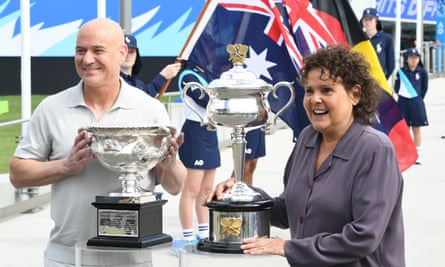Australian Open director Craig Tiley has defended the health of the tournament after the Victorian government spent tens of millions of dollars to support Tennis Australia during the coronavirus pandemic.
The 2024 event is targeting a record 1 million visitors and will start on Sunday for the first time, extending the duration of the so-called “Happy Slam” by one day.
“This is Victoria’s event, it’s the Victorian taxpayers’ event and it’s their event,” Tilly said at the launch of the championship at Melbourne Park. But as speculation continues about the future of the tennis calendar, Tilley denied the Australian Grand Slam would go bankrupt without taxpayer support.
“From a financial perspective, we have some options,” Tilley said. “We did a lot of work last year to ensure we had sufficient funding to kick-start our plans for 2024 and 2025.”
Tennis Australia’s financial accounts submitted to ASIC in December showed the state government had forgiven $43 million in loans accumulated by the organization during the COVID-19 pandemic.
As a result of this “one-time derecognition,” the organization reported a surplus of $62 million for fiscal 2023, but its financial loss for the period still increased to $6.4 million.
Revenue increased from $499 million to $542 million, including funding from the Australian Sports Commission, the Department of Foreign Affairs and the national tourism agency.

Tilley said his organization wanted to make the most of the Melbourne Park District and invest in the coming years, but the pandemic had tested his organization’s finances.
“Last year was more about reducing costs so we can accelerate investment in the future,” he said.
Victoria’s Deputy Premier Ben Carroll highlighted the results of the state’s investment.
“The statistics speak for themselves. The Australian Open has contributed $2.7 billion to the Victorian economy over the past 10 years.”
The move from 14 to 15 days of competition is expected to generate more than $10 million in additional revenue annually through ticket sales and broadcast revenue. The Australian Open is the second Grand Slam tournament to make this change, following the 2006 French Open.
Tiley said this was to reduce the likelihood of early rounds ending late at night, but it meant players had to spend more time in Melbourne and the event encroached on a calendar traditionally devoted to preliminary rounds.

Four-time champion Andre Agassi said there are pros and cons to extending the tournament.
Newsletter Promotion Post
“The downside is that the players’ games will be affected, like the earlier final in Adelaide, but I think overall it’s a win and gives the fans a chance to be here.”
Last year’s event drew a record attendance of 839,192, 27,000 more than the previous record. This year’s qualifying week attracted 89,894 people, more than 26,000 more than in 2023.
Carroll said the 2024 goal of 1 million visits is realistic.
“When you factor in Chinese, Japanese and US tourism, the Australian dollar and the great weather we’re experiencing in Melbourne today, there’s every reason to believe we’ll have well over a million people here.”
Tilley said weather could be a major obstacle.
“This is Melbourne and we know the weather is going to change in two-and-a-half weeks, but at the end of the day, we know we have plenty of opportunity for our fans to have a good time.”
Reports in recent months have suggested that the tennis calendar is under pressure from new investment, similar to what is happening in golf with the Saudi-backed LIV Golf Tour.
Two top men’s players, Novak Djokovic and Carlos Alcaraz, competed in the Riyadh Season Tennis Cup two weeks ago and are already considering hosting a major event in the region to start the new season.
Tilly, who reportedly helped galvanize the Grand Slam common interest in pushing for change, said he sympathized with the ATP and WTA.
“It’s a very difficult problem to solve, but players do need an offseason and they need a really good offseason.”

